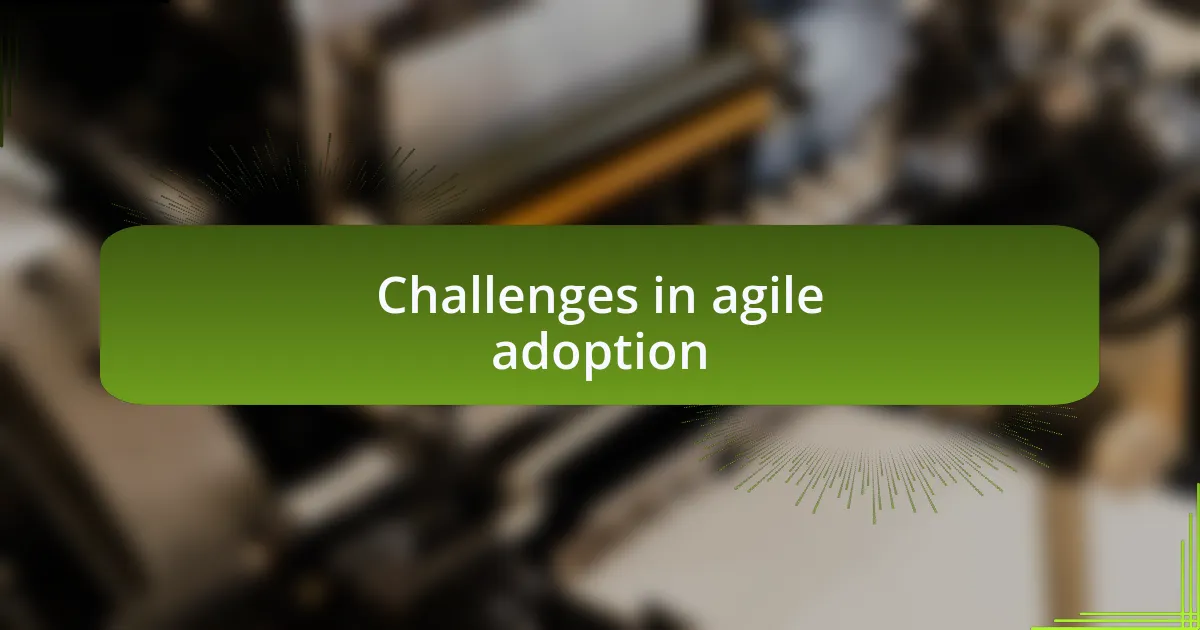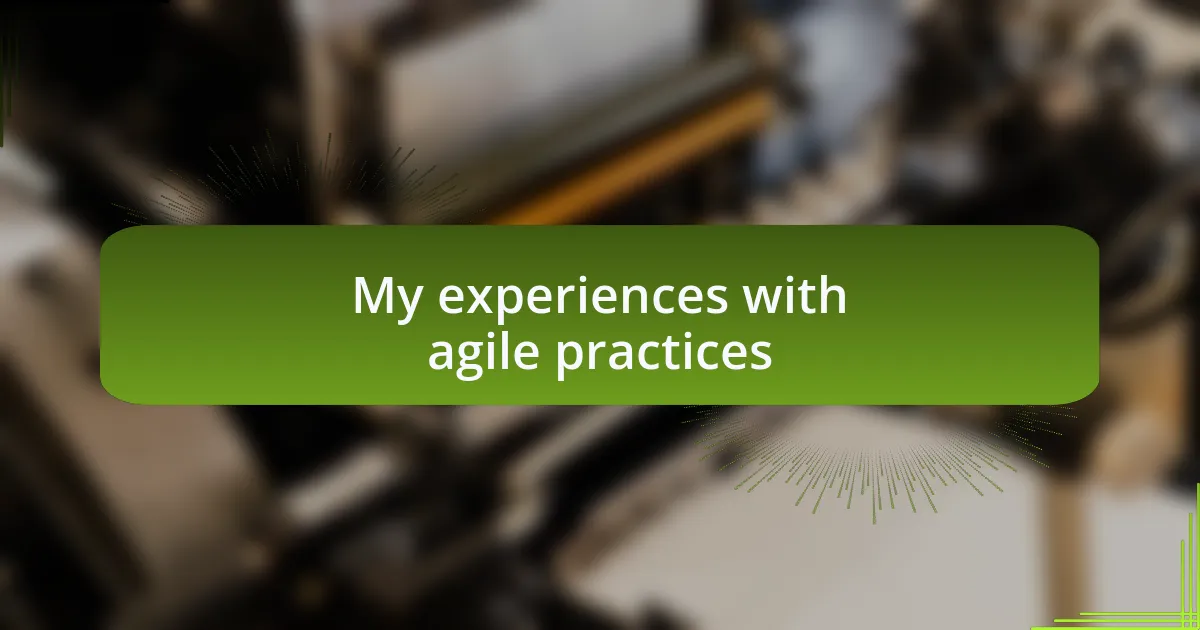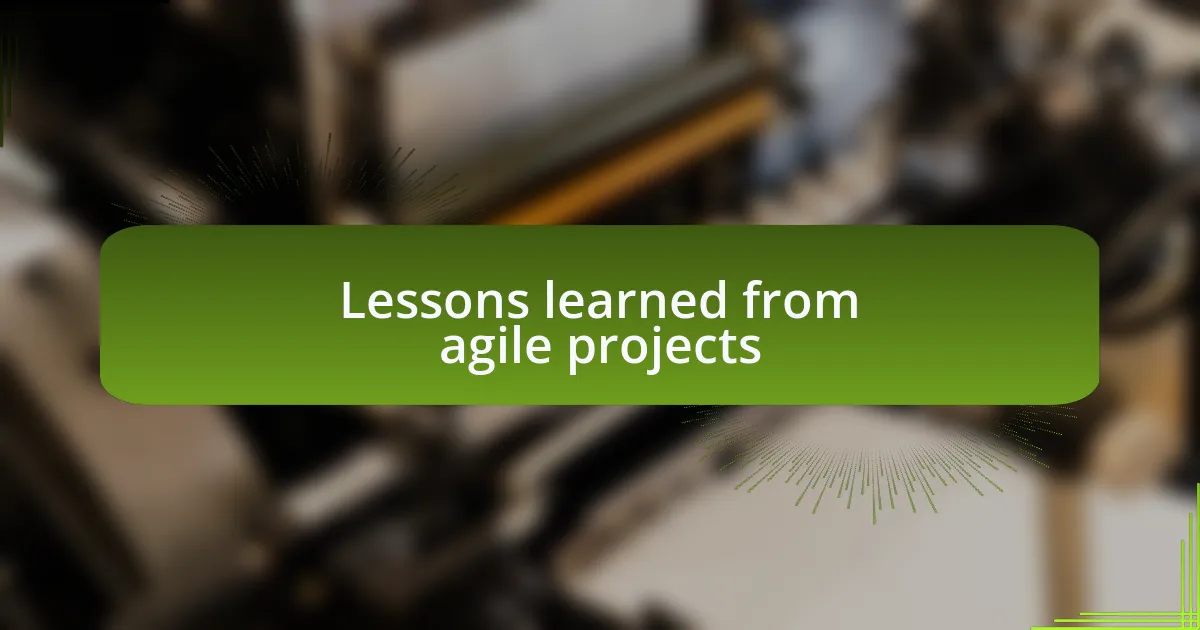Key takeaways:
- Agile methodologies emphasize collaboration, customer feedback, and adaptability, leading to more relevant products and stronger team dynamics.
- Frequent delivery of working software and responsiveness to change enables teams to gather feedback early and pivot quickly, enhancing client relationships.
- Challenges in adopting Agile include cultural resistance, understanding Agile principles, and maintaining effective communication within teams.
- The future of Agile in engineering will likely involve hybrid methodologies, increased automation, and enhanced cross-disciplinary collaboration.

Understanding agile methodologies
Agile methodologies are frameworks designed to facilitate adaptive planning and iterative development, which set them apart from more traditional, rigid project management approaches. I remember my first experience using Agile; the flexibility was refreshing. Instead of being locked into a single plan, we regularly reassessed our goals and adjusted our path forward, creating a dynamic work environment that felt more collaborative and engaged.
At its core, Agile prioritizes collaboration and customer feedback, which resonates deeply with me. This approach not only encourages teams to work together closely but also allows them to integrate user input more meaningfully, leading to products that truly meet client needs. Have you ever found yourself frustrated with a product that missed the mark? Agile methodologies strive to prevent that by emphasizing continuous delivery and the importance of staying in tune with the end user.
Embracing Agile can initially be daunting, requiring a shift in mindset for many teams, including my own when we first adopted it. The beauty of Agile, however, lies in its emphasis on learning and growth through feedback loops. It’s a powerful reminder that every iteration, regardless of its outcome, holds value in teaching us something new about our project and ourselves.

Key principles of agile
Agile methodologies rest on several key principles, which make them distinct and effective. One of these principles is the emphasis on individuals and interactions over processes and tools. I can’t tell you how refreshing it was to witness my team come together during a sprint, brainstorming and problem-solving in real time. This personal connection often led to innovative solutions that rigid processes could never accommodate.
Another essential principle is the delivery of working software frequently, with a preference for shorter timescales. I recall a project where we adopted two-week sprints, allowing us to release updates more regularly. This rhythm not only kept our clients excited but also allowed us to gather feedback early and pivot quickly when necessary. Have you ever wished you could respond faster to customer needs? This is exactly what Agile aims for.
Furthermore, Agile emphasizes responsiveness to change rather than sticking rigidly to a plan. I vividly remember a project where we had to adjust our direction based on unexpected market feedback. Embracing that change was initially unsettling, but ultimately, it led to a much more relevant product. Isn’t it fascinating how flexibility can often lead to the most rewarding outcomes? That adaptability is a crucial element of what makes Agile so effective in today’s fast-paced environment.

Benefits of agile methodologies
The benefits of Agile methodologies are numerous and often transformative for teams. One of the most significant advantages I’ve noticed is increased collaboration. In my experience, when team members feel a sense of ownership and connection to their work, it fosters not just productivity but also creativity. I remember our group sessions where every voice mattered, and it was incredible to see ideas evolve into actionable solutions. Have you ever been part of a team that just clicked? That synergy makes all the difference.
Another benefit is the enhanced ability to respond to customer feedback quickly. I once worked on a project where we integrated client feedback into our sprints almost immediately, leading to a product that truly resonated with our users. This approach not only strengthened client relationships but also instilled a sense of trust. It’s amazing how directly listening to feedback can keep the project aligned with real needs—don’t you think that’s what every team should strive for?
Also, the iterative nature of Agile allows for continuous improvement. I remember after a few sprints, our team conducted retrospectives which led to identifying pain points and celebrating wins. This habit of reflection helped us not only to fine-tune our processes but also to enhance morale and team spirit. Wouldn’t it be beneficial if every project included moments for reflection and growth? Embracing this culture of improvement has been a game-changer for us.

Challenges in agile adoption
Adopting Agile methodologies can be daunting for many organizations, mainly due to cultural resistance. I once joined a team that was entrenched in traditional project management practices, and I could feel the tension in the room during our first Agile meeting. People were reluctant to let go of their familiar processes. Isn’t it challenging to break old habits, especially when comfort zones are at stake?
Another significant hurdle is ensuring everyone on the team truly understands Agile principles. In one project, I noticed that misunderstanding Scrum roles led to confusion and inefficiencies, slowing down our progress instead of speeding it up. It makes me wonder—how can we bridge that knowledge gap? A proper training and onboarding process could have alleviated so much uncertainty.
Lastly, maintaining consistent communication can be a struggle. I remember working in a distributed environment where time zones affected our daily stand-ups. It was frustrating to juggle schedules just to keep everyone on the same page. Have you ever experienced that feeling of disconnection? It’s crucial to establish clear channels to keep team members aligned, no matter where they are.

My experiences with agile practices
During my time implementing Agile practices, I discovered the immense value of quick iterations. In one project, we adopted two-week sprints. I found that breaking tasks into smaller, manageable chunks didn’t just enhance our productivity; it also sparked creative solutions that I might have missed in a more rigid framework. Have you ever noticed how fresh ideas often emerge when you’re not bogged down by lengthy planning phases?
However, not every Agile experience was smooth sailing. On another project, I faced a team member who struggled to embrace the collaborative nature of Agile. I vividly remember a particular sprint retrospective when their defensiveness surfaced, making it challenging to foster open dialogue. It was a reminder of how important it is to cultivate a trusting atmosphere where everyone feels safe to share their insights. Building that trust can sometimes feel like a full-time job in itself, right?
One refreshing aspect of Agile was the regular feedback loops. I recall presenting my work to stakeholders after just one sprint. Their immediate input felt invigorating, almost like a collaborative dance where both sides contributed to the rhythm of development. This experience reinforced my belief that embracing feedback not only enhances the product but also strengthens relationships within the team. Have you ever felt that powerful synergy when everyone pulls together toward a common goal?

Lessons learned from agile projects
Throughout my agile journey, one critical lesson was the importance of adaptability. I remember a project where we had set a roadmap, but halfway through, the client’s priorities shifted dramatically. Instead of resisting change, we revised our approach during the next sprint, which not only satisfied the client but also kept my team motivated. Have you ever experienced a project pivot that, rather than throwing you off course, actually led to greater success?
Another insight I gained was the significance of clear communication. During an early agile project, I noticed that my assumptions about what team members were working on often led to confusion and overlap. By implementing daily stand-ups, we not only clarified our tasks but also fostered camaraderie. Have you felt the difference a few minutes of structured conversation can make in aligning a team’s efforts?
I’ve learned that reflecting on our processes is crucial for continuous improvement. After one sprint, I led a retrospective focused not only on deliverables but also on our team’s morale. By sharing each other’s experiences, we uncovered underlying issues that were affecting our productivity. Isn’t it fascinating how sometimes the most significant barriers aren’t the technical challenges but the emotional ones?

Future of agile in engineering
The future of agile in engineering seems promising as organizations are increasingly embracing hybrid methodologies. I recall a project where we combined agile with traditional waterfall approaches—it was a game-changer. This blending allowed us to maintain structure while enjoying the flexibility that agile offers. Have you noticed how this fusion might just become the norm, redefining project management paradigms?
As technology evolves, agile teams will probably integrate more automation into their processes. I once worked on a development cycle where we utilized automated testing alongside our agile iterations. This not only sped up our feedback loops but also reduced the stress on the team, enabling us to innovate more freely. Can you imagine how enhanced tools will lead to even more dynamic iterations in future engineering projects?
Moreover, the emphasis on collaboration across disciplines is set to grow. In one cross-functional project I participated in, I witnessed firsthand how engineers, designers, and even marketing professionals worked together in real-time during sprints. This collective effort not only accelerated our delivery but also fostered a sense of shared ownership among the team. How pivotal do you think such collaborations will be in streamlining workflows in the engineering sector going forward?